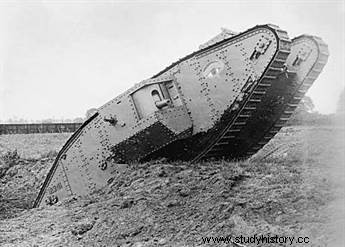 During the First World War and for the first time in history, 49 tanks or “tanks were engaged in the Battle of the Somme , thee September 15, 1916. These “armored tracked vehicles” were soon to become tanks capable of crossing waterways and forest massifs. If the concept of thetank goes far back in history, the development of an operational armored vehicle will only become possible at the beginning of the 20th century, after the invention of the internal combustion engine and caterpillars. Tanks capable of ending positional warfare and deciding the outcome of two world wars, thereby revolutionizing the art of war.
During the First World War and for the first time in history, 49 tanks or “tanks were engaged in the Battle of the Somme , thee September 15, 1916. These “armored tracked vehicles” were soon to become tanks capable of crossing waterways and forest massifs. If the concept of thetank goes far back in history, the development of an operational armored vehicle will only become possible at the beginning of the 20th century, after the invention of the internal combustion engine and caterpillars. Tanks capable of ending positional warfare and deciding the outcome of two world wars, thereby revolutionizing the art of war.
Siege towers to the first armored vehicles
How to advance in cover under enemy fire? This oxymoronic question has haunted military strategists throughout history. The idea of a mobile weapon protecting its occupants seems, in fact, as old as the idea of war. During ancient times, the Greeks built huge siege towers called Helepolis . Assyrian archers used mobile protections as well as siege engines that could accommodate two soldiers and had gigantic water ladles that allowed them to extinguish a possible outbreak of fire.
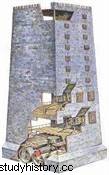 The Chinese had invented the Dongwu Che to protect their soldiers on the battlefield. The Romans had mobile towers , protected by shields, moving on wheels and equipped with catapults. Indians and Persians successfully used war elephants. Czechs and Poles had steel "war chariots" in the Middle Ages. Leonardo da Vinci had finally drawn the plans for a combat vehicle on wheels, and equipped with guns whose movement would be ensured by human force.
The Chinese had invented the Dongwu Che to protect their soldiers on the battlefield. The Romans had mobile towers , protected by shields, moving on wheels and equipped with catapults. Indians and Persians successfully used war elephants. Czechs and Poles had steel "war chariots" in the Middle Ages. Leonardo da Vinci had finally drawn the plans for a combat vehicle on wheels, and equipped with guns whose movement would be ensured by human force.
Most of these weapons were used in siege situations where tactical formations and maneuvers were of less importance. This problem nevertheless appeared urgent to solve, when the technological progress linked to the Industrial Revolution threatened to transform the war into a vast siege, prefiguring the war of position and the trenches. Other mobile weapons include armored trains . If these can carry heavy loads, their movements remain conditioned by the presence of railways. They are also very vulnerable.
Aircraft are able to attack ground positions but cannot, of course, capture land objectives . As for the armored vehicles, first used by the British, they proved their effectiveness in combat but do not appear suitable when it comes to crossing rough terrain, marshes, trenches or even courtyards. water (notably due to the small contact surface between the wheels and the ground).
The years preceding the First World War were the subject of significant progress in this area, with in particular the generalization of the automobile and the improvement of the spark-ignition engine (gasoline engine). New vehicles called machine guns, or self-propelled cannons, are being developed (which essentially consist of machine guns or cannons mounted on vehicles), as well as armored vehicles. The first British armored vehicle was the Motor Scout, a quadricycle flanked by a Maxim machine gun and partly protected by light armour, developed by Frederick Richard Simms in 1898.
Tanks to end positional warfare
The British are in fact the first to consider responding to the problem of progression under enemy fire with a new type of vehicle combining tracks, armor, turrets and various weapons. The British writer Herbert George Wells also participated in this revolution in strategic thinking by describing in his short story The Land Ironclads, published in December 1903 in The Strand Magazine, the use of massive vehicles, heavily armored and maneuverable in any type of terrain, armed with cannons and machine guns and which would be able to cross a system of fortified trenches in order to clear the ground and in fact facilitate the advance of the infantry.
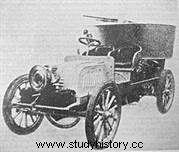 The French companies Charron and Girardot &Voigt produced an armoured vehicle equipped with a Hotchkiss machine gun and 7mm armor in 1902, notably described by military historian Ed Ellsworth Bartholomew in his book Early Armored Cars. Spencer Tucker and Priscilla Mary Roberts underline in their World War One encyclopedia, that the Austrians were for their part the first to develop with Austro-Daimler armored vehicles with turret in 1904 (based on the plans of the lieutenant colonel of the Austrian army Hungarian Graf Schonfeld), such machines having served in particular during the Italo-Turkish war of 1911-1912.
The French companies Charron and Girardot &Voigt produced an armoured vehicle equipped with a Hotchkiss machine gun and 7mm armor in 1902, notably described by military historian Ed Ellsworth Bartholomew in his book Early Armored Cars. Spencer Tucker and Priscilla Mary Roberts underline in their World War One encyclopedia, that the Austrians were for their part the first to develop with Austro-Daimler armored vehicles with turret in 1904 (based on the plans of the lieutenant colonel of the Austrian army Hungarian Graf Schonfeld), such machines having served in particular during the Italo-Turkish war of 1911-1912.
For military historian Bruce Gudmundsson (On Armour), the First World War contributed to the emergence of a new demand for heavily armored self-propelled armaments that could move in any type of terrain, making the development of "tanks" inevitable (tested for the first time by the British against Dutch settlers during the Second Boer War in 1902). The use of armored vehicles during the First World War would thus respond to the urgent need to put an end to the war of position – a need which itself echoes this old problem of progress under cover despite fire. enemy. The major defect of armored vehicles being their poor maneuverability, except on flat ground, new developments appeared necessary.
The principle of these "tanks" is to mobilize firepower equivalent to that of artillery and machine guns through no man's land separating the trench networks while protecting its occupants from enemy fire. The tactical role thus assigned to the tanks therefore consists of accompanying the infantry to break through the front, leaving the cavalry to exploit the breakthrough. For Marc Ferro (The Great War), "it was necessary at all costs to manufacture an all-terrain vehicle that could protect infantry attacks, remove barbed wire, destroy machine gun nests and progress at the same time as the troops".
Although faced with the nightmare of positional warfare after a few weeks of fighting, few military strategists during the First World War understood that the internal combustion engine would carry a revolution in the art of war . The latter, fitted to planes and tanks, would indeed soon increase their mobility and therefore their effectiveness in combat, prefiguring the development of large mechanized forces which would assume the role hitherto held by cavalry. These mechanized forces were to become twenty years later the armored divisions of the Second World War.
If in 1914, many prototypes of all-terrain armored vehicles had already been imagined, it was indeed because of the Great War that their development accelerated, the Colonel of the French Army Jean-Baptiste Eugène Estienne having affirmed from the August 23, 1914 that "victory will belong[it] in this war to the one of the two belligerents who will be the first to place a 75 gun on a vehicle capable of moving all terrain ".  Arnold D. Harvey also demonstrates in Collision of empires:Britain in three world wars, 1793-1945 that the British and French advances were almost simultaneous in this area. Indeed, as British war correspondent on the Western Front Ernest Dunlop Swinton (he was appointed by Minister of War Herbert Kitchener) admitted, "Colonel Estienne was seized at the same time as [the British] from the idea that a weapon with the characteristics of future tanks was necessary to help the infantry". The French began to study plans for armored vehicles in January 1915 and to test the principle from May, that is to say two months before the test of the Little Willie in England, the prototype of the Mark tank I. While the Little Willie became the first tank prototype to be produced, French military strategists were testing a prototype armored vehicle, the Schneider CA1, at Souain. The British were nevertheless the first to engage tanks on the battlefield during the Battle of the Somme in September 1916.
Arnold D. Harvey also demonstrates in Collision of empires:Britain in three world wars, 1793-1945 that the British and French advances were almost simultaneous in this area. Indeed, as British war correspondent on the Western Front Ernest Dunlop Swinton (he was appointed by Minister of War Herbert Kitchener) admitted, "Colonel Estienne was seized at the same time as [the British] from the idea that a weapon with the characteristics of future tanks was necessary to help the infantry". The French began to study plans for armored vehicles in January 1915 and to test the principle from May, that is to say two months before the test of the Little Willie in England, the prototype of the Mark tank I. While the Little Willie became the first tank prototype to be produced, French military strategists were testing a prototype armored vehicle, the Schneider CA1, at Souain. The British were nevertheless the first to engage tanks on the battlefield during the Battle of the Somme in September 1916.
First prototypes of “armored tracked vehicles”
The first prototypes of these "tracked armored vehicles" were developed at the beginning of the century. In 1905, the polytechnician and Captain of the French Army Léon Levavasseur proposed to the Ministry of War a vehicle project described by Chris Ellis and Peter Chamberlain in Armored Fighting Vehicles of the World as "having all the characteristics later required for the design tanks, including in particular a 75mm gun mounted in front of a kind of steel box and self-propelled by articulated wheels. This self-propelled gun would have accommodated three soldiers as well as ammunition and would be suitable for any type of terrain. ". This project of “automotive artillery piece” as the ministry describes it was finally rejected on August 13, 1908, the British engineer David Roberts having already developed a similar vehicle, the Hornsby. A few years later, in 1911, the Austrian military engineer Günther Burstyn and the Australian civil engineer Lancelot de Mole were also to develop tank projects rejected by their respective governments.
Armored tracked vehicles were nevertheless marketed from 1908, particularly in the United States. The French Army also used them from the start of the Great War to move its heavy artillery pieces over rough terrain.
The French also experimented between 1914 and 1915 with the Boirault vehicle aimed at destroying barbed wire and exploiting breakthroughs on the battlefield. This vehicle consists of parallel tracks revolving around a triangular motorized center. However, remaining too fragile, too slow and very unwieldy, it was quickly abandoned.
French tank prototypes
In his book Dawn of Glory, Autos-Mitrailleuses and French Tanks during the Great War, military historian Alain Gougaud also highlights the work of the engineer under construction Paul Frot who, in December 1914, proposed to the French Ministry the plans for an “armoured roller” nevertheless devoid of tracks. His prototype, baptized Frot-Laffy, was tested on March 18, 1915 and succeeded in destroying barbed wire but was also too slow and very unwieldy. This project was thus abandoned in favor of that of General Estienne, the "Estienne Tractor".
The French tried in 1915 to develop vehicles with heavy armament and armor mounted on tractor chassis, among which was the Fortin Aubriot-Gabet which was powered by an electric cable and armed with a 37 mm naval gun but turns out to be unusable.
In January of the same year, the arms manufacturer Schneider &Co. commissioned its project manager Eugène Brillié to study the tracked tractors of the American manufacturer Holt Company. On his return from the New Continent, Brillié, who had already participated in the design of armored vehicles in Spain, managed to convince his company to launch a development study for an armored and armed tractor based on a Baby Holt chassis.
The tests that were initiated in May 1915 in the Schneider factory highlighted the superiority of the 45-hp tracked Baby Holt. On June 16, new tests are carried out in front of the President of the Republic Raymond Poincaré, then on September 10 in front of Commander Ferrus. The first successful armored vehicle was finally tested in Souain on December 9, 1915 in front of French Army officers (including Colonel Estienne).
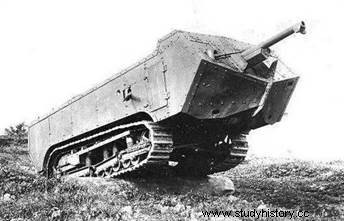 On December 12, this same Estienne presented to the General Staff a project aimed at setting up a force armored vehicle equipped with caterpillars. The plan was approved and in a letter dated January 31, 1916, Generalissimo Joseph Joffre ordered the production of 400 tanks (the production order for 400 Schneider CA1 being nevertheless actually given on February 25, 1916). Shortly after, on April 8, 1916, 400 other Saint-Chamond tanks were ordered. Schneider, however, having difficulty in meeting production deadlines, tank deliveries were spread over several months from September 8, 1916. The Saint-Chamond tanks were to be delivered from April 27, 1917 (according to Ernest Dunlop Swinton in Eyewitness; being personal reminiscences of certain phases of the Great War).
On December 12, this same Estienne presented to the General Staff a project aimed at setting up a force armored vehicle equipped with caterpillars. The plan was approved and in a letter dated January 31, 1916, Generalissimo Joseph Joffre ordered the production of 400 tanks (the production order for 400 Schneider CA1 being nevertheless actually given on February 25, 1916). Shortly after, on April 8, 1916, 400 other Saint-Chamond tanks were ordered. Schneider, however, having difficulty in meeting production deadlines, tank deliveries were spread over several months from September 8, 1916. The Saint-Chamond tanks were to be delivered from April 27, 1917 (according to Ernest Dunlop Swinton in Eyewitness; being personal reminiscences of certain phases of the Great War).
British tank prototypes
The United Kingdom is the other great power to have tested many tank prototypes during the first years of the war. As early as June 1914, British Army Major Duncan John Glasfurd submitted the idea of a vehicle equipped with a chain of wheels (“pedrail wheels”) capable of attacking enemy lines. In July 1914, engineer, war correspondent and Lieutenant-Colonel Ernest Swinton vaguely got wind of the development of Holt tractors and their ability to navigate rough terrain. By his own admission, however, he did not make the connection between the principle of tracks and the need for an all-terrain armed vehicle until September.
As early as October 1914, Sinwton recommended to the British Committee for the Defense of the Empire in a letter sent to Secretary Maurice Hankey (and reported by Van Lee in Vin Rouge, Vin Blanc, Many Vin, the American Expeditionary Force in WWI) that tracked tractors be armored and armed for use in combat. Hankey subsequently succeeded in convincing the War Office which, although skeptical, agreed to test a Holt tractor on February 17, 1915. Its chain was nevertheless blocked by mud, the project was abandoned, and the War Office abandoned for a whole new development time.
He nevertheless resumed his experiments in May 1915 with the Tritton Trench-Crosser, a vehicle equipped with large tractor wheels 8 feet in diameter and carrying beams that would allow him to cross the trenches. However, the vehicle turned out to be too cumbersome and was also abandoned.
The Royal Navy and the Landships Committee ("Tank Committee") created on February 20, 1915 and led by Winston Churchill agree to promote the testing of armored tractors as "tanks ". In March of the same year, Churchill ordered the production of 18 experimental tanks, including 12 using Diploack tracks (a principle notably defended by the Royal Navy officer Murray Sueter) and 6 using large wheels (an idea defended by the Royal Naval Air Service Officer Thomas Gerald Hetherington). Their production was nevertheless discontinued, the wheels being too wide and too fragile, and the tracks too cumbersome and not powerful enough.
Because of the failure of so many projects, the principle of massive tanks was abandoned by the British in June 1915. The Landships Committee would now study smaller prototypes . The test of an American tracked machine, the Bullock Creeping Grip, also ended in failure in July 1915. The machine was modified, and the new vehicle called No1 Lincoln Machine was built on August 11, 1915, before to be tested on September 10. This attempt is again a failure.
Developments continue, however, with particular emphasis on new track models. The Little Willie was thus tested on December 3, 1915. A rhomboid-shaped model was then developed to compensate for its poor all-terrain capabilities, the machine being then known as the Centipede or Mother, inaugurating the Big Willie tanks. The tests conducted from January 29, 1916 proved to be conclusive this time and the War Office placed an order on February 12 for 100 units intended for use in France. 50 new units are ordered in April. The first British tanks were born.
 Convinced of the usefulness of these tanks, the British were the first to engage them on the front in 1916. In order to keep the presence of these tanks in France secret, the British call them "tanks rather than the official designation of “landships”. They thus suggest that the armor plates are intended for oil tanks. The Tank Museum in London also reports the testimony of the Secretary of the Admiralty of the Landhips Committee Albert Stern, who specifies that other terms such as "water tank" or "cistern" had been studied.
Convinced of the usefulness of these tanks, the British were the first to engage them on the front in 1916. In order to keep the presence of these tanks in France secret, the British call them "tanks rather than the official designation of “landships”. They thus suggest that the armor plates are intended for oil tanks. The Tank Museum in London also reports the testimony of the Secretary of the Admiralty of the Landhips Committee Albert Stern, who specifies that other terms such as "water tank" or "cistern" had been studied.
British military strategists intended to accumulate these devices in France in the greatest secrecy in order to engage them massively without the Germans knowing about it beforehand. Furthermore, some of these 'tanks' were built in locomotive factories in Glasgow ironically called 'tank shops'. This secrecy surrounding tank development, coupled with the skepticism of most infantry commanders, nevertheless prevents infantry soldiers from receiving significant training to prepare them to fight with tanks.
General Haig engages the first tanks in history on the Somme
British General Douglas Haig who commands British forces in France, however, is so eager to gain ground during the Battle of the Somme , that he wishes to have the first 60 machines available. After a battle of attrition lasting several weeks, a new offensive was launched on September 15, 1916 by General Haig to the southwest of Bapaume. 11 divisions, including 2 Canadian, are engaged with 49 leading tanks. Only 32 made it to the starting line and 21 were finally entered. Supported by some of them, the brand new 41st division succeeded in advancing more than three kilometers. Supported by two of these vehicles, the 2nd Canadian Division seized Courcelette, and High Wood finally fell. However, it is impossible to advance the tanks in wooded terrain. Despite these initial successes, the German defensive system again demonstrated its solidity, although the fighting continued for several days. In addition, General Haig commits for Robin Prior and Trevor Wilson (The First World War) the error of not preceding the assault with an artillery barrage in order to protect his tanks from allied fire. The areas where the tanks were engaged turned out to be those where the German resistance was the strongest. After ten days of fighting, the majority of the tanks were out of action.
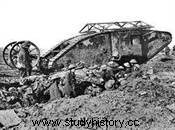 The appearance of the first tanks on the battlefields of the Great War obviously caused surprise general . On the Somme, however, they brought nothing decisive to the outcome of the fighting. They are too dispersed by the Allied General Staff, and the terrain does not lend itself to an armored assault. It turns out to be so muddy that the men themselves struggle to move forward. Moreover, their disappointing performance only heightens the contempt of conservative officers. "My poor Land Ships were released prematurely and on too mediocre a scale, yet there was a real victory behind this idea", laments Winston Churchill. Ernest Dunlop Swinton was then relieved of his duties as head of British armored units. After the Somme, the Ministry of War even tries to cancel an order for 1,000 new armored vehicles? and when some of them silt up in the Passchendaele swamps, he takes the opportunity to lower production from 4,000 to 1,300 tanks.
The appearance of the first tanks on the battlefields of the Great War obviously caused surprise general . On the Somme, however, they brought nothing decisive to the outcome of the fighting. They are too dispersed by the Allied General Staff, and the terrain does not lend itself to an armored assault. It turns out to be so muddy that the men themselves struggle to move forward. Moreover, their disappointing performance only heightens the contempt of conservative officers. "My poor Land Ships were released prematurely and on too mediocre a scale, yet there was a real victory behind this idea", laments Winston Churchill. Ernest Dunlop Swinton was then relieved of his duties as head of British armored units. After the Somme, the Ministry of War even tries to cancel an order for 1,000 new armored vehicles? and when some of them silt up in the Passchendaele swamps, he takes the opportunity to lower production from 4,000 to 1,300 tanks.
“Instead of questioning its own judgment, comments the British military historian Basil Liddell Hart, the General Staff gradually lost all confidence in the tanks. ". But above all, the Germans had been able to capture some of these tanks and were already developing a projectile model to destroy them. Haig's failure on the Somme is in fact also a strategic failure. Any effect of surprise linked to the engagement of armored vehicles is therefore lost.
The first experience of the French was also hardly conclusive:they engaged their tanks during the great Nivelle offensive on April 17, 1917. The huge Saint- Chamond of 27 tons are nevertheless very vulnerable . The heavy machine guns and German cannons destroyed 60 out of 120. “The crews were grilled alive, the infantry now unprotected were massacred” says Marc Ferro. The Germans conclude from this that the cannon would always prevail over the tank. They are committing an error that was to be fatal to them.
The Battle of Flers-Courcelette
The batail of Flers-Courcelette which began on September 15, 1916 and lasted a week, was the third and last major offensive launched by the British Army during the Battle of the Somme.
Like the first two British offensives during the Battle of the Somme (the Battle of Albert on July 1 and the Battle of Pont Bazentin on July 14), Haig hopes be able to break through the German defenses and break with the positional war . Engaging General Rawlinson's British IV Army and part of the Reserve Army (which was to become Gough's Fifth Army), Haig planned for XV Corps to break through the German lines northeast of Flers, allowing the cavalry to infiltrate the enemy rear. The majority of troops engaged were assigned three or four objectives which were mostly to be captured on the first day of the battle if a breakthrough was achieved.
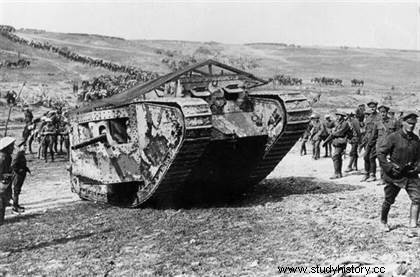 The initial attack was preceded by a massive artillery bombardment. The 1
st
July, the offensive is supported by a field gun every 20 meters from the front and a heavy gun every 50 meters. These numbers are even higher at Flers-Courcelette where there is a field gun every 9 meters and a heavy gun every 26 meters. One of the disadvantages of the artillery barrage ie However, tanks, being slow, must be engaged before infantry. Thus, sections of the front must be spared from the artillery barrage to allow the tanks to advance. As a result of this strategy, points where German resistance will prove strong (and which were naturally tank targets) are not bombed.
The initial attack was preceded by a massive artillery bombardment. The 1
st
July, the offensive is supported by a field gun every 20 meters from the front and a heavy gun every 50 meters. These numbers are even higher at Flers-Courcelette where there is a field gun every 9 meters and a heavy gun every 26 meters. One of the disadvantages of the artillery barrage ie However, tanks, being slow, must be engaged before infantry. Thus, sections of the front must be spared from the artillery barrage to allow the tanks to advance. As a result of this strategy, points where German resistance will prove strong (and which were naturally tank targets) are not bombed.
On September 15, the first day of the battle, the advance of the XIV Corps was mixed. The 56 th Division which was to cover the right flank of the attack is stopped. On the left flank, the 6 th Division faces, to the north of Leuze wood, an imposing German fortified position, the "Quadrilateral". She fails to make significant progress despite fierce fighting. The Guards Division manages to capture its first objectives, not without difficulty. She nevertheless stopped her progress, thinking she had captured her third objective, as the battles she had to fight until then were trying.
On the right, the XV Corps offensive was more successful, but failed to achieve the hoped-for breakthrough. The attack is supported by 14 tanks (4 others allocated to him could not take part). The 14 th Division must clear a pocket of German resistance east of Delville Wood. This attack is led by two companies of the 6 th battalion of the "King's Own Yorkshire" Light Infantry Division supported by a tank. The assault launched in the morning at 5:30 a.m. was a success, despite the loss of all the officers.
The three divisions of the XV Corps (the 14 th , the 41 th and the New Zealand Division) achieved most of their objectives. In the center, the 41 th Division which was to seize Flers, had been allocated the most tanks. The village of Flers was captured early in the day, one of the tanks having enabled the infantry to advance under cover across the central avenue. However, the advance was halted once the village was captured. The fourth objective which was synonymous with breakthrough cannot be achieved.
III Corps got mixed results on September 15th. On its left flank, the 15 th Division managed to capture the village of Martinpuich but on its right, the 50 th and 15 th Divisions have to settle for meager progress. Finally, on the far left of the British offensive, General Gough's Canadian Army Reserve Corps
reaches its final objective at 8:25 a.m. and manages to exploit this success by capturing the village of Courcelette.
The attack is renewed on September 16 without much success. The Guards Division suffered heavy losses and had to be relieved. In the center, the XVth Corps launches its attack at 9:25 in the morning. After an ineffective artillery bombardment, the 14 th Division is unable to progress. The attack of the 21 th Division led by the 64 th Brigadier General Headlam's brigade is stopped around Flers. His only tank is destroyed by an artillery shell. The headquarters of the signaling brigade was also destroyed in Flers by artillery. The New Zealand Division repelled a German counterattack and made limited progress before being halted by Allied command due to failure on the right flank. The III Corps also made only meager progress.
September 17, General Rawlinson orders the resumption of the offensive the day after. The planned attack was nevertheless postponed until September 21 before being called off. The fighting did not resume on the front of the IVth Army until around Morval, to the east. During the last seven days of the battle of Flers-Courcelette, the British launched a series of limited attacks in order to consolidate their lines, in particular around "High Wood" where the failure of September 15 allowed the Germans to form a projection. The rains increased from September 18, discouraging any attempt to attack.
The Battle of Flers-Courcelette is overall a success much more important than the attack of the 1 st July but it fails to fulfill its initial objective, to break through the German lines. Although the British units had almost reached the German rear, the German General Staff had demonstrated that it still had sufficient reserves to re-establish its lines. Cet affrontement marque également l’apparition des tanks sur les champs de bataille de la Première Guerre Mondiale, les attentes à l’égard de cette nouvelle arme étant très élevées.
Les performances au combat des tanks britanniques Mark I se révèlent néanmoins décevantes et le commandant en chef des forces britanniques en France, le Général Douglas Haig est très critiqué pour avoir engagé cette arme secrète de manière si précoce. Il avait pourtant été averti par les commandants sous ses ordres (comme Ernest Dunlop Swinton) et par le gouvernement français qui avait dépêché à Londres le Colonel Jean-Baptiste Eugène Estienne et le Sous-secrétaire d’Etat aux inventions Jean-Louis Bréton pour convaincre le gouvernement britannique d’annuler l’ordre d’Haig. Il est en revanche plausible que les faibles performances des tanks sur la Somme confortèrent, à tort, le Haut commandement allemand dans son idée qu’ils étaient une arme inefficace, retardant ainsi ses propres programmes de développement de chars. L’expérience acquise durant la bataille de Flers-Courcelette permit en outre d’améliorer la conception des tanks.
Bien que l’engagement de tanks sur la Somme puisse laisser à postuler de la perte de l’effet de surprise, les évènements de la bataille de Cambrai (du 20 novembre au 7 décembre 1917) doivent mener à une analyse plus nuancée. A Cambrai, les tanks sont concentrés et réussissent à briser les lignes allemandes. Même si ce succès ne peut être exploité du fait de la contre-attaque allemande, il révèle que les Allemands n’avaient su mettre au point d’arme anti-char suffisamment efficace.
Les actions des soldats canadiens sur la Somme sont enfin commémorées par le Mémorial de Courcelette sur la D929 (Albert-Bapaume), au sud du village de Courcelette.
 Malgré des débuts incertains sur la Somme, les britaniques engagent en 1917 leurs chars de type Mark . A la suite de la bataille de Cambrai, une évidence s’impose à tous les Etats-major :engager des chars de manière massive était le moyen le plus efficace de percer les lignes ennemies en déplorant un minimum de pertes humaines, même face à des tranchées très bien défendues.
Malgré des débuts incertains sur la Somme, les britaniques engagent en 1917 leurs chars de type Mark . A la suite de la bataille de Cambrai, une évidence s’impose à tous les Etats-major :engager des chars de manière massive était le moyen le plus efficace de percer les lignes ennemies en déplorant un minimum de pertes humaines, même face à des tranchées très bien défendues. Les Mark britanniques au front, de Bullecourt à Cambrai
En 1917, l’Entente envisage une rupture du front du fait de deux offensives :l'une française au Chemin des dames , l'autre britannique devant Arras. L'attaque du village de Bullecourt, situé au sud-est d’Arras, voit l’Etat-major britannique engager à nouveau les tanks Mark.
Le 11 avril 1917, deux brigades australiennes attaquent ainsi Bullecourt appuyées par 12 tanks mais sans le moindre soutien d'artillerie. Pris sous un feu d'enfilade, les Australiens doivent néanmoins se replier. Les pertes de la 4ème Brigade s'élèvent à 2258 sur un effectif de 3000 hommes. Les Allemands capturent en outre 27 officiers et 1137 hommes et ne déplorent que 750 tués. Le 3 mai 1917, une deuxième attaque est menée par les 62ème et 2ème Division australienne sur les deux flancs du village. Bullecourt est enfin capturé mais les Britanniques ne parviennent pas à percer la ligne Hindenburg. Au total, les pertes britanniques et australiennes s'élèvent à 14000 hommes.
Les chars MK-1 et quelques nouveaux MK-2 envoyés sur le terrain neigeux de Bullecourt auront été cloués au sol. Non pas du fait du terrain, mais parce que les nouvelles cartouches allemandes percent le blindage des chars. Les fantassins allemands percevaient 5 de ces cartouches de type « K » équipées même des mitrailleuses.
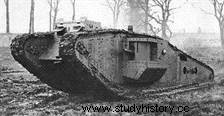 Les Britanniques retiennent toutefois la leçon. Ils revoient le mode de fixation des plaques de blindage . Le nouveau char MK-IV fait ainsi appel à des blindages plus épais, résistants aux projectiles spéciaux des allemands. Le système de ventilation interne des blindés est également repensé et amélioré. Les MK-4 entrent en action en juin 1917 à Messines.
Les Britanniques retiennent toutefois la leçon. Ils revoient le mode de fixation des plaques de blindage . Le nouveau char MK-IV fait ainsi appel à des blindages plus épais, résistants aux projectiles spéciaux des allemands. Le système de ventilation interne des blindés est également repensé et amélioré. Les MK-4 entrent en action en juin 1917 à Messines.
Après le désastre de l'offensive Nivelle et la boucherie du Chemin des Dames, le Général Philippe Pétain décide de rester sur la défensive en attendant les chars et les troupes américaines. Le Général Douglas Haig, commandant en chef du Corps expéditionnaire britannique opte quant à lui, pour une grande offensive dans les Flandres . L'action préliminaire de cette dernière consiste alors à capturer la crête de Wytschaete (8 kilomètres de long et parfois 84 mètres d'altitude). Le village de Messines (au sud d’Ypres) n'étant entouré que d'une colline et d’aucune crête, l’Etat-major britannique estime pouvoir réduire le saillant autour de Wytschaete. C’est la tâche confiée à la IIème armée du Général Herbert Plumer.
Les chars engagés, soit environ 75 MK-4, ont pour mission de soutenir l'infanterie, mais non d'opérer eux-même la percée (ils ont pour principale tâche de nettoyer les nids de mitrailleuse). Cette fois, la préparation d’artillerie devait être massive. Le Général Herbert Plumer avait en effet ordonné une préparation de 17 jours précédant le jour de l’attaque fixé au 7 juin. Il déclare ainsi à son Etat-major avant la bataille :« Messieurs, nous n'écrirons peut-être pas l'Histoire demain, mais nous changerons certainement la géographie ».
Les chars devaient arriver la veille de la bataille afin d'éviter qu’ils ne soient repérés. En outre, le bruit généré par leur déplacement couvre toute communication entre les véhicules. Il était donc nécessaire d'utiliser des marquages au sol pour que les unités blindées puissent gagner leurs positions. Faute de marquage, des guides devaient conduire les blindés. Privés tant de guides que de marquages, certains équipages de blindés devaient trouver seuls leurs positions en se basant sur des croquis ou sur les montées de l'infanterie. Arrivés au but, ils sont exténués avant même le début de la bataille.
L’attaque de Messines est l’une des plus réussie de la guerre pour l’Entente. Après les explosions, les Britanniques et les troupes du Commonwealth (Australiens et Néo-Zélandais) passent à l'attaque et réussissent à coiffer rapidement le point sud de la crête. En deux heures seulement, certaines unités atteignent la deuxième ligne allemande et à 7 heures, les villages de Messines et de Wytschaete (capturé par les troupes irlandaises des 16ème et 36ème divisions) tombent aux mains des Alliés. Les troupes britanniques commencent alors à descendre le versant est de la crête, et l'artillerie est poussée en avant.
En début d'après-midi, les tanks et les troupes en réserve entrent en action. Enfin à 15 heures 10, les objectifs sont atteints. La crête est tenue, les Britanniques s'enterrent et réussissent à contenir les contre-attaques allemandes. La coopération entre les chars MK-4 et l’infanterie s’avéra bien meilleure à Messines que durant les précédents engagements de tanks. Les chars détruisirent les nids de mitrailleuses allemands, permettant à l’infanterie d’occuper facilement le terrain. Même embourbés, ils constituaient des points d'appui pour l'infanterie. Mais cet assaut n'aura pas permis de montrer toute l'étendue de leur potentiel. Une fois encore, les blindés s'étaient en effet vus assigner des objectifs secondaires. Ils prouvèrent néanmoins qu’ils pouvaient jouer un rôle plus important que celui d’un simple soutien de l’infanterie.
Les officiers spécialisés de l'arme blindée poussaient déjà depuis un certain temps les Etats-major vers un changement radical dans l'emploi des chars. Ils demandaient surtout que l'on emploie les blindés sur des terrains assez plats , c'est-à-dire pas encore pilonnés par l'artillerie et obtinrent satisfaction. La première bataille de Cambrai allait leur donner raison.
La bataille de Cambrai
Après la troisième campagne d’Ypres en 1917, le front ouest semble demeurer figé jusqu’au retour du beau temps. Néanmoins, les Etats-major britanniques et allemands ont d’autres idées en tête. Le Général Haig prépare une nouvelle action pour effacer l’échec des Flandres. Il conclut après réflexion que le secteur de Cambrai demeure le plus propice pour une telle offensive, les lignes allemandes n’y étant pas aussi défendues qu’ailleurs. Haig rassemble donc une armée comprenant notamment un important soutien de l’artillerie et des tanks, mais ne peut constituer de réserves du fait des pertes importantes subies dans les Flandres et de l’activité sur le front italien. L’absence de réserves lui donne ainsi l’avantage de la surprise mais pas la possibilité de l’exploiter.
Le secteur de Cambrai est notamment choisi car il n'a pas beaucoup subi les bombardements d’artillerie. Le terrain dégagé et plat qu’il présente apparaît donc idoine pour un engagement massif de blindés. De nouvelles techniques de tir d’artillerie sont en outre employées à Cambrai. Les positions ennemies étant désormais repérées à l’avance, les tirs sont ajustés par le biais de cartes et non plus en observant simplement les points d’impact. Ainsi, les tirs de barrage d’artillerie s’avèrent plus précis et plus efficaces, l’effet de surprise des bombardements étant restauré puisque le tir de salves préliminaires n’est plus nécessaire.
Des tranchées antichars larges et profondes avaient néanmoins été creusées par les Allemands. Les Britanniques imaginèrent de grouper les chars par 3, chacun emportant une grosse fascine. Le premier jetterait sa fascine dans la tranchée, les deux autres passant dessus et ainsi de suite.
La IIIème Armée britannique du Général Julian Byng ouvre la bataille de Cambrai. L’attaque principale conduite par des chars Mark IV fait face à une section de la ligne Hindenburg défendue par la IIème Armée allemande du Général Georg von der Marwitz. Le plan du Général Byng vise à percer les positions allemandes entre le canal de l'Escaut et le canal du nord. La cavalerie doit ensuite avancer rapidement sur Cambrai, tandis que les unités d'infanteries et les tanks prennent la crête de Bourlon avant d'avancer au nord-est sur Valenciennes.
La bataille débute le 20 novembre 1917 par un bref tir de barrage de 1 000 pièces d'artilleries pour briser la résistance de la ligne Hindenburg. L'attaque principale est menée par 476 chars d'assaut (environ 380 en première ligne et une centaine en réserve). C’est la première utilisation massive de tanks de la guerre. Ces blindés sont suivis par 6 des 19 divisions du Général Byng et avancent de 8 kilomètres sur le front. Les premières attaques sont décisives. La ligne Hindenburg est percée par endroits de 9 à 12 kilomètres, sauf à Flesquières où les Allemands résistent avec acharnement et parviennent à neutraliser plusieurs chars. En outre, la mauvaise coordination entre l'infanterie et les tanks britanniques contribue ici encore à ralentir leur progression.

Malgré les grands progrès réalisés dès le premier jour de la bataille, les Britanniques rencontrent beaucoup de difficultés à maintenir leur rythme de progression. De nombreux chars d'assauts connaissent en effet des défaillances mécaniques , s'embourbant notamment dans les fondrières ou étant détruits par des tirs d'artillerie allemande à courte portée. La bataille se concentre autour de la crête de Bourlon, à l'ouest de Cambrai.
Le 30 novembre, les troupes allemandes engagées contre la IIIème armée britannique du Général Byng, entament des contre-attaques en vue de regagner le terrain perdu. Le Prince consort Rupprecht de Bavière, commandant du secteur menacé, a ainsi dépêché des renforts considérables au secours de la IIème armée du Général von der Marwitz qui a, jusque-là, essuyé le gros de l'attaque.
Les contres attaques allemandes sont particulièrement efficaces, principalement pour trois raisons que sont l'utilisation d'un tir de barrage bref, l'emploi de nouvelles unités de soldats d'assaut (des Sturmtruppen, comme contre les Russes à Riga) et le soutien apporté par des avions à basse altitude aux unités en première ligne. Les Britanniques, trop déployés et manquant de réserves, sont contraints d'abandonner une grande partie du territoire âprement gagné. Le 3 décembre, le Général Haig donne l'ordre de retrait du saillant et le 7 décembre, tout le terrain conquis par les Britanniques est abandonné à l'exception d'une partie de la ligne Hindenburg autour d'Havrincourt, de Ribécourt et de Flesquières. Les Allemands gagnent en revanche une bande de terrain au sud de Welsh ridge.
A Cambrai, les tanks qui n’avaient pu tenir seuls le terrain durent certes se replier. Mais peu à peu, une évidence s’impose à tous les Etats-major :engager des chars de manière massive était le moyen le plus efficace de percer les lignes ennemies en déplorant un minimum de pertes humaines, même face à des tranchées très bien défendues.
L’Entente aura ainsi produit plus de 6000 chars durant la Grande Guerre. Des chars que l'on allait bientôt baptiser « les chars de la victoire ". Des chars qu’une poignée d’officiers allemands zélés, dont un certain Guderian, allaient étudier après la guerre en vue de venger la défaite de 1918.
Les français adoptent le char Renault
Les chars lourds Saint-Chamond étant lents et peu maniables, l’Etat-major français donna rapidement la préférence aux tanks légers de Renault, Berliet et Schneider sans abandonner toutefois les Saint-Chamond qui, seuls, pouvaient franchir les coupures de deux mètres. Leur construction en grande série (Renault FT-17 et Schneider C.A.1 notamment) permit dès lors à l’Entente d’appuyer ses offensives par de larges déploiements d’engins blindés.
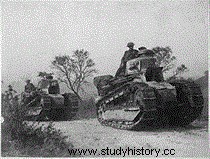
L'offensive est notamment menée par la IVème armée britannique du Général Rawlinson qui doit avancer méthodiquement sur un front de 25 kilomètres. L'attaque est précédée par un bref barrage d’artillerie avant qu’un peu plus de 400 tanks ouvrent l'avancée des 11 divisions britanniques engagées dans la première phase de l'assaut. L'aile gauche de la Ière armée française du Général Eugène Debeney soutient par ailleurs l'offensive britannique. Les défenses allemandes sont assurées par la IIème armée du Général Georg von der Marwitz et la XVIIIème armée du Général Oskar von Hutier. Les deux généraux allemands disposent de 14 divisions en ligne et de 9 en réserve. L'attaque franco-britannique est un plein succès et les Allemands sont contraints de battre en retraite de 15 kilomètres.
Le comportement de l'armée allemande est en réalité inquiétant pour l’Etat-major et semble de mauvais présage pour la suite des hostilités. Certaines unités en première ligne ont simplement fuit les combats sans opposer beaucoup de résistance, malgré les nouvelles armes anti-tank allemandes (Gewehr 1918). D'autres (quelque 15 000 soldats) se sont rapidement rendus. Quand la nouvelle parvient au général Ludendorff, chef d'Etat-major général adjoint, il qualifie le 8 août de « jour noir pour l'armée allemande ». Mais la situation ne s'arrange pas. Le lendemain, de nombreux autres soldats allemands sont faits prisonniers.
Le 10 août, la bataille d'Amiens évolue vers le sud du saillant tenu par les Allemands. La IIIème armée française se dirige sur Montdidier et force les Allemands à abandonner la ville, permettant la réouverture de la ligne ferrée Amiens-Paris.
La première phase de l'offensive alliée arrive ainsi à son terme face à la résistance accrue des Allemands le 12 août. Cependant, leur défaite est nette . Les pertes allemandes s'élèvent à 40 000 hommes tués, blessés et 33 000 faits prisonniers. Les pertes françaises et britanniques totalisent 46 000 soldats. La bataille d’Amiens restera le plus grand affrontement de chars de la Grande Guerre, les nouveaux MK-V britanniques constituant l’essentiel des bataillons d’assaut. La cavalerie seule ayant en outre été décimée par endroits ou ayant dû fuir devant des nids de mitrailleuses allemands, les blindés semblaient déjà devoir dominer les champs de bataille.
Comme une ironie de l’histoire
L’armée allemande n’aura au contraire jamais cru à l’efficacité des blindés et fut de fait très en retard dans ce domaine. Seuls 20 chars A7V, des « boîtes blindées » peu manœuvrables, sont ainsi construits en 1918. Les derniers affrontements de la guerre voient pourtant se confirmer l’efficacité des tanks .
Lors de sa première grande opération indépendante durant la bataille de Saint-Mihiel en septembre 1918, l’Armée américaine engage 267 chars, tous de fabrication française, dont des FT-17, sous le commandement d’un certain Lieutenant-colonel George Patton qui devait brillamment s’illustrer durant la Seconde guerre mondiale. En novembre 1918, il y a plus de 2 000 chars français en ligne , les Français en ayant construit 4146 sur l’ensemble du conflit pour 2542 pour les Britanniques.
L’Entente aura ainsi produit plus de 6000 chars durant la Grande Guerre. Des chars qu'on allait bientôt baptiser « les chars de la victoire ». Des chars qu’une poignée d’officiers allemands zélés allaient étudier après la guerre en vue de venger la défaite de 1918. Des chars dont l’un des plus célèbres d’entre eux, le Général Heinz Guderian, dira, non sans clairvoyance, que « s’ils réussissent, la victoire suivra ». Comme une ironie de l’histoire, ces mêmes chars devaient en effet écraser l’Armée française deux décades plus tard et offrir par là même sa revanche à l’Armée allemande.
Bibliography
- Robin Prior &Trevor Wilson, La Première Guerre mondiale :1914 - 1918. Autrement, 2001.
- Les chars de la Grande Guerre de Paul Malmassari. 14-18 Editions, 2010.
- La guerre des chars 1916-1918 de Henri Ortholan.
